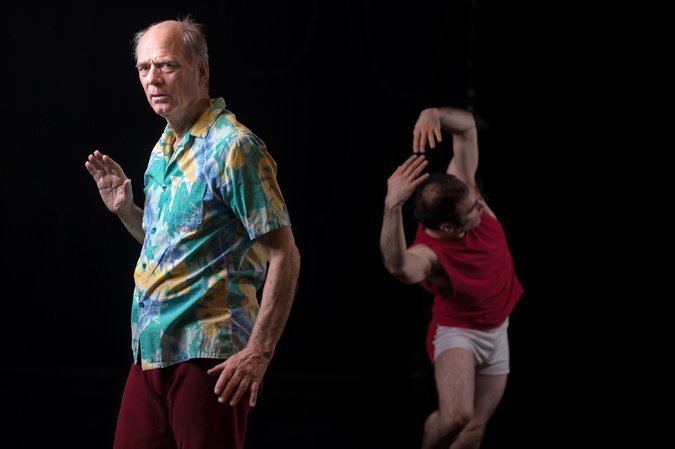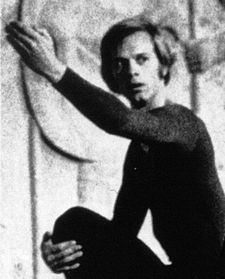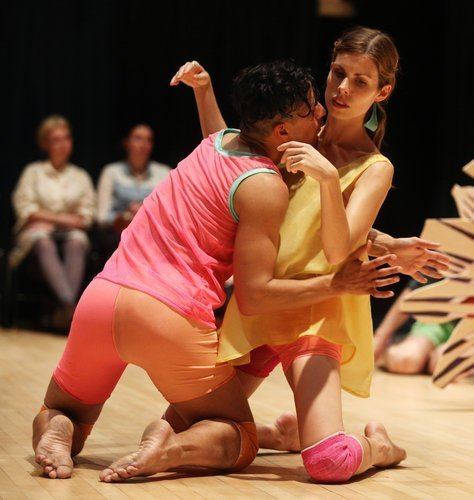Name Douglas Dunn Role Dancer | Movies Night Fantasies | |
 | ||
Occupation dancer and choreographer Education Princeton University (1964) Awards Guggenheim Fellowship for Creative Arts, US & Canada | ||
Douglas dunn dancers two step
Douglas Dunn (born October 19, 1942) is an American postmodernist dancer and choreographer. He is considered a highly eclectic and minimalist postmodern choreographer, who uses humor, props, and text in his dances.
Contents
- Douglas dunn dancers two step
- Cleave by douglas dunn
- Training and education
- Performing career
- Choreography
- Collaborations
- Awards
- References

Cleave by douglas dunn
Training and education

Douglas Dunn started dancing in college in 1962, studying under Audreé Estey, Maggie Sinclair, and Roland Guerard at the Princeton Ballet Society. In 1963 he attended the Jacob's Pillow Dance Festival where he studied under Margaret Jenkins, Ted Shawn, Matteo, Margaret Craske, La Meri, and Gus Solomons, Jr. Dunn received his B.A in 1964 in Art History from Princeton University in New Jersey. After college he continued his studies at the Martha Graham summer program in 1963 and 1964, the Joffrey Ballet School from 1964–1965 and the Margaret Jenkins Studio. Dunn moved to New York in 1968 where he started training at the American Ballet Center with Françoise Martinez and at the Merce Cunningham School.
Performing career

In New York, Dunn began working with Yvonne Rainer and was a dancer with her company from 1968-1970. After completion of his studies with the Merce Cunningham studio, he was accepted into their professional company as a dancer from 1969-1973. In 1970 he became a member of the avant-garde improvisational group the The Grand Union until 1976.
Choreography

Dunn premiered his professional company, Douglas Dunn and Dancers, in 1976, where he served as artistic director. He was commissioned by various companies to choreograph works including the Paris Opera Ballet, Groupe de Recherche Choréographique de l'Opéra de Paris, Grande Ballet de Bordeaux, New Dance Ensemble of Minneapolis, Walker Art Center (Minneapolis), Repertory Dance Theater (Salt Lake City), Ballet Théâtre Francais de Nancy, Institute for Contemporary Art (Boston), Perth Institute of Contemporary Art (Australia), and Portland State University (Oregon).
Dunn uses many different choreographic elements in his dances which makes it hard to classify him into a specific genre of dance. He conveyed a minimalist approach in his work by using elements of silence, stillness, simple movements, text, pedestrian movements, gestures and humor. He also incorporated varying aesthetics like costumes, music, set designs and lights. In 101, a performance exhibit choreographed in 1974, Dunn used his apartment to create a maze of cubes of rough-hewn lumber that covered his entire loft. For four hours a day and six days a week in two months he held an open studio for viewers to enter the set and explore his creation in which they would find him lying on top of the boxes in a sort of trance with his eyes closed. Dunn's seven best-known works are, Nevada, Four for Nothing, 101, Octopus, Time Out, Gestures in Red, and Lazy Madge. He is mostly known for creating solo pieces like Lazy Madge, Haole, and Nevada. However he also created many group pieces like Celeste in 1977 which featured about forty dancers. In 1980, Dunn created Pulcinella as a commission for the Paris Opera Ballet. He was commissioned by l'Opéra de Paris in 1981 to set his work, Cycles, on the Groupe de Recherche Chorégraphique.
Collaborations
Since the 1980s, Dunn expressed a growing interest in collaborations with many different artists as well as presenting site-specific and evening length works. Dunn collaborated with many choreographers including Sara Rudner, David Gordon, Pat Catterson, and Sheela Raj.
He has worked with poets like Reed Bye and Anne Waldman. His piece 'Aubade' had costumes, video and lighting by Charles Atlas, and poetry by Anne Waldman. He also collaborated with Waldman on a performance featuring art of Kiki Smith, and musicians Ha-Yang Kim, Daniel Carter, Ambrose Bye, and Devin Brahja Waldman, performed by and set to Anne Waldman's poem Jaguar Harmonics.
His important film collaborations include, Mayonnaise-Part I directed by Charles Atlas, 101 by Amy Greenfield, Secret of the Waterfall by Susan Dowling and directed by Charles Atlas. His solo work, The Myth of Modern Dance was also directed by Charles Atlas in 1990 which was based on his previous solo, Haole in 1988, a comedic piece. In the 1990s, his major film works included Rubble Dance and Long Island City both directed by Rudy Burckhardt which were shot outside in industrial venues around Queens. He collaborated with painter Mimi Gross to create sets and costumes and Carol Mullins to designs lights in Sky Eye in 1989, Caracole in 1995, and Spell for Opening the Mouth of N in 1996. In 1983, Dunn collaborated with sculptor Jeffrey Schiff and composer John Driscoll to create a dance installation piece entitled Second Mesa for the Institute of Contemporary Art in Boston. In a collaboration with sculptor David Ireland, Stucco Moon, was created in 1992 with the use of costumes, sets and sounds which was performed in many locations including a gymnasium, a museum, and a conventional theater. Each time this piece was performed the set design was reconfigured according to each performance space which also allowed for changes and variations in the choreography and costuming. In 1994, Disappearances, a site specific work, consisted of dancers randomly placed throughout different crowds in New York during lunchtime where they executed movement with simple gestures.
Awards
Dunn has received many awards and Fellowships including Cowles Chair, University of Minnesota, the National Endowment for the Arts, New York State Council on the Arts, John Simon Guggenheim Memorial Foundation, New York Foundation for the Arts, Lila Wallace-Reader's Digest Fund, Foundation for Contemporary Performance Arts, and Creative Arts Public Service Program. In 2008, the French Embassy in New York, presented Douglas Dunn with the insignia of the French Ordre des Arts et des Lettres, inducting him into the Order as a "Chevalier," who has "significantly contributed to the enrichment of the French cultural inheritance." In 1998, Dunn received a New York Dance and Performance Award, a “Bessie.” Dunn received a 1997 Foundation for Contemporary Arts Grants to Artists Award.
